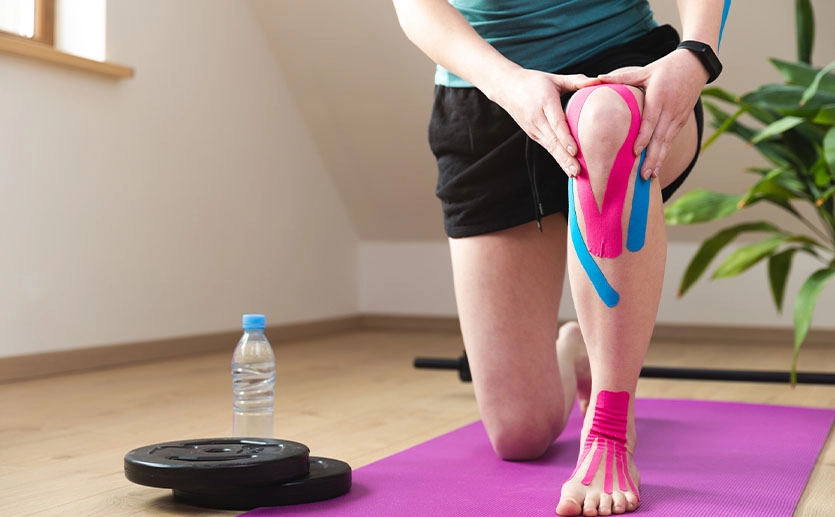If you’ve ever rolled your ankle, tweaked your shoulder, or pushed your knees past their limit during a workout, someone probably suggested, “Just tape it.” Simple advice, right? But then you walk into a store or scroll online and realize—there are like ten different kinds of tape. Elastic ones, rigid ones, colorful ones, waterproof ones… what are they all for?
That’s where things get confusing. But here’s the deal: knowing the different types of athletic tape and how they work is a total game changer, whether you’re an athlete, a weekend warrior, or just trying to stay active without pain.
At Revolution Rehab, we don’t just slap tape on and call it a day. We use the right tape for the right reason, and we want you to understand how and why it works—so you’re not wasting your time (or making things worse).
Let’s break it down.
Why Understanding Athletic Tape Actually Matters
Tape isn’t just for pros. It’s one of the most underrated tools in injury prevention, performance, and recovery. When used correctly, the right type of athletic tape can:
- Reduce pain and inflammation
- Improve joint stability
- Encourage proper movement patterns
- Support injured tissues while still allowing mobility
But when used incorrectly—or if the wrong type is applied—it can do absolutely nothing. Or worse, it can cause circulation issues, skin irritation, or throw off your biomechanics.
Bottom line? Understanding the types of athletic tape is key to using them effectively. Let’s dive into how each one works and when to use them.
The Main Types of Athletic Tape (And What Each One Does)
1. Kinesiology Tape (aka K-Tape)
What it is: You’ve probably seen this one before—brightly colored, stretchy, and applied in wild patterns across shoulders, backs, and knees. Kinesiology tape mimics the elasticity of skin.
What it’s used for:
- Muscle activation
- Swelling and lymphatic drainage
- Joint support without limiting movement
- Pain relief
Best for: Soft tissue injuries, postural support, or boosting body awareness. It’s not going to hold a joint in place, but it helps guide how your body moves.
Pro tip: It works best when applied to clean, dry skin and can last 3–5 days—even through workouts and showers.
2. Rigid Athletic Tape (aka Zinc Oxide Tape)
What it is: Non-elastic, super strong, and the OG tape used in sports like football, hockey, and soccer. This one doesn’t mess around.
What it’s used for:
- Joint immobilization
- Ligament support
- Restricting movement to protect an injury
Best for: Serious joint taping—think ankle sprains, shoulder dislocations, or fingers that need to stay locked in place.
Pro tip: This tape often requires an underwrap to prevent skin irritation. Once it’s on, it’s not coming off easy (and that’s the point).
3. Elastic Adhesive Bandage (EAB)
What it is: A blend between rigid tape and kinesiology tape. It’s stretchy but thick, and it provides moderate compression.
What it’s used for:
- Compression and support without full restriction
- Muscle support for larger muscle groups
- Wrapping over joints to reduce swelling
Best for: Wrapping over thighs, hamstrings, or calves during heavy training. It provides a balance of support and flexibility.
4. Cohesive Tape (aka Self-Adhering Wraps)
What it is: Think of it as the “Velcro” of tape—it only sticks to itself, not your skin.
What it’s used for:
- Compression
- Securing ice packs or bandages
- Post-injury swelling control
Best for: Athletes with sensitive skin or anyone who needs short-term support. It’s reusable and easy to remove.
5. Leukotape and Cover-Roll Combo
What it is: A powerhouse duo. Cover-Roll acts as a skin-friendly base, and Leukotape is a rigid, high-tension tape that’s used on top for corrective taping.
What it’s used for:
- Patellar tracking issues
- Shoulder positioning
- Postural corrections
Best for: Athletes dealing with repetitive strain injuries or movement dysfunctions.
Pro tip: This is often used by physical therapists—like the ones at Revolution Rehab—to retrain movement without over-restricting mobility.
Common Tape-Related Mistakes (That You’ll Want to Avoid)
- Using tape as a cure-all – Tape is a tool, not a fix. It should be part of a broader plan.
- Not prepping the skin – Oil, sweat, or lotions? Forget it. The tape won’t stick.
- Wrong type for the wrong job – Using kinesiology tape when you need joint stability? Not helpful.
- Too tight – This can restrict blood flow and actually make things worse.
If you’re unsure about what tape to use, the safest bet is to have a pro show you how—and that’s where we come in.
Diagnosing When to Use Athletic Tape (And When to Skip It)
Taping isn’t for every ache or pain. Knowing when to tape—and when to seek more advanced care—is crucial.
Ask yourself:
- Is this a new injury or chronic?
- Is there bruising, swelling, or numbness?
- Does pain change with movement or load?
- Have you been taping this same area over and over?
If you’ve answered yes to most of these—or your pain isn’t improving—it’s probably time to get evaluated by a physiotherapist or sports rehab specialist. At Revolution Rehab, we help you figure out not just where to tape, but whether taping is even the right solution.
Treatment Options That Pair Well With Taping
Athletic tape isn’t a standalone treatment. It works best when combined with:
- Manual therapy to improve joint and muscle function
- Rehab exercises that reinforce correct movement
- Dry needling or cupping to speed up healing
- Strengthening and mobility drills for long-term results
And yes, we offer all of the above at our clinic. We customize every treatment plan based on what your body needs—not just a copy-paste approach from YouTube.
Preventing Injury With the Right Tape and Routine
Taping can be preventative, especially if you’re dealing with recurring strain. Here’s what we recommend to our active clients:
- Learn how to self-apply the right tape
- Keep skin clean and prepped before taping
- Don’t rely on tape alone—use it as reinforcement, not crutches
- Focus on mobility, stability, and form during training
We also guide clients through prehab programs that strengthen weak points before they turn into injuries.
So… Which Type of Tape Do You Need?
That depends on your body, your sport, and your specific injury history. And we’re not just saying that to be vague.
Taping isn’t one-size-fits-all—and unfortunately, that’s how it’s treated most of the time. At Revolution Rehab, we take a detailed look at your movement patterns, joint mechanics, and injury history before recommending anything.
Ready to Tape Smarter? Book Your Assessment Today
Don’t guess your way through an injury. Whether you’re trying to get back in the game, reduce pain during training, or prevent another flare-up, the right taping strategy makes all the difference.
At Revolution Rehab, we combine expert taping techniques with personalized rehab plans to help you move better, faster, and pain-free.
Book your consultation today at one of our locations, and let’s make sure you’re using the right type of athletic tape for the right reason.


